PAINTINGS
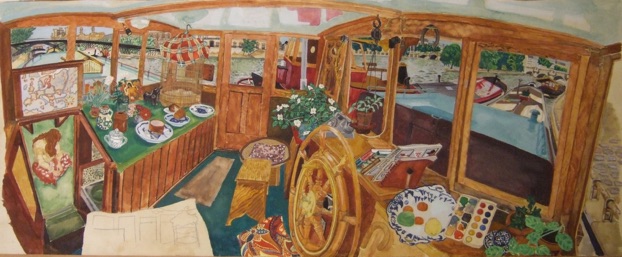
I did this watercolor of my wife, Nancy, mourning her father, Sol, in October 1977 from the wheelhouse of the Klaidonis - the barge we rented between the Passerelle des Arts and Pont Neuf. The Louvre can be glimpsed across the river and Sterling Hayden’s barge is moored upstream, on the right, towards the Île de la Cité. Nancy was grieving on the floor of the rear cabin, down the steps, below the hatch with the old map. The 270-degree view was largely done with the school paints pictured at bottom right.
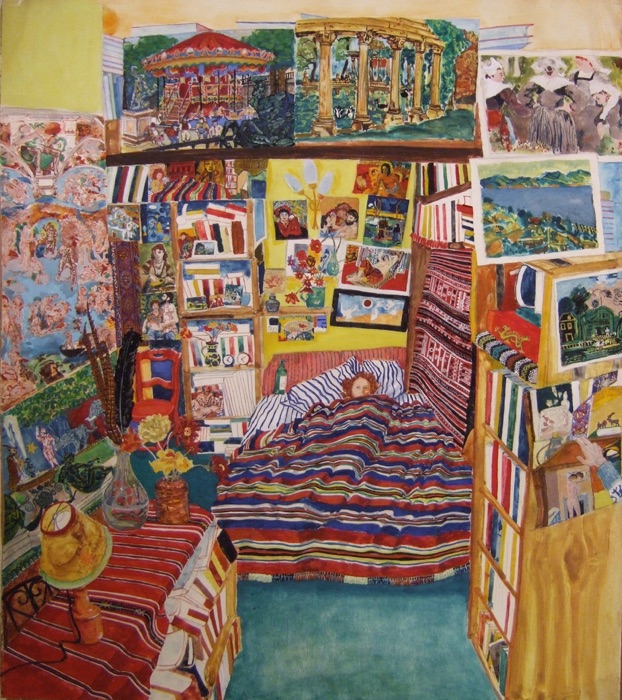
We were living in a maid’s room on the rue de Champs de Mars in early 1977 and I had been bouncing around our one-room “studio”, playing the roles in some film for Nancy, who was in bed with bronchitis, when she told me to take advantage of the sunshine and spend some time outside. I got as far as the landing and looked back, whereupon I set up an easel amid a flow of astonished people going up and down the staircase as I painted Nancy in bed with a bottle of cider.
The sketch of two clowns, leading an elephant and her calf into a circus tent beyond a fountain, was painted near Metro Réaumur-Sébastopol, where there was a small circus that kept its pair of elephants in a bankrupt theater. The scene above the red chair shows Nancy and me at the Parc de Sceaux seconds before I suffered a severe concussion doing two-man somersaults, with my hands gripping Trevor Smith’s ankles and vice versa. Trevor and his best friend, Geoffrey Rush, lived with the two of us at times while studying mime in Paris. Later, they went onto bold acting careers - Trevor as the star of a London troupe under the name Trevor Stuart and Geoffrey to major film roles, one of which - in Shine - won him an Oscar.
After skinny-dipping in the long reflecting pools that May evening in 1976, I saw a shallow circular one jittering in still air and predicted that an earthquake had occurred. Sure enough, hundreds of people were killed just then in the Friuli region in northern Italy.
The scene at top left shows an old woman watching men play pétanque by a carousel beyond a Barye bronze of a lion killing a horse in the Tuileries Garden. To the right of the lamp above the bed is a scene of Trevor and Nancy teasing me as I wrote my novel, No Man’s Land, bare-chested during the torrid drought of 1976. Another sketch shows Nancy in bed from the other direction, where a hot plate served as our kitchen. Above her, one can just see the poster of Ramses the Second’s sarcophagus, which holds vigil over us to this day.
Prints of some of our favorite paintings were also scattered around the room, with the Sistine Chapel end wall above the clowns at left, a Duffy river scene, Cezanne seascape, Matisse odalisque, Picasso and Corot portraits of women, several Bonnards and Gauguins, and, finally, by the red chair, Stanley Spencer’s “Portrait of the Artist and his Second Wife in Bed with a Leg of Lamb” - a painting I copied in the Tate. Last of all, the painting at bottom right shows my arm reaching for the shelf above Nancy’s head. The tiny plastic reindeer and mandrill toys on the book in this sketch were our totem animals.
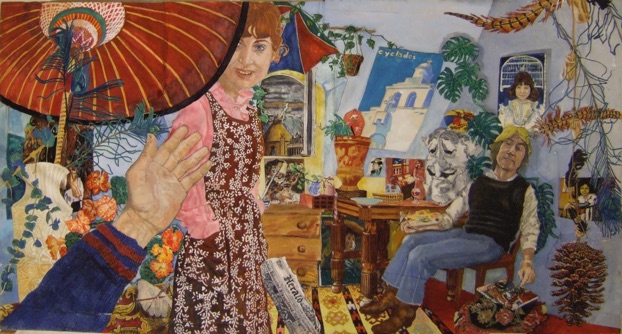
After wandering to Paris from around the world, our friends found refuge in the city’s garrets. One October afternoon in 1977, Peters Day - who later became the political cartoonist and illustrator, la Mouche - started painting Nancy and me as it thundered outside. Instead of posing, I typically began to gesticulate and expound. But, after a while, the peacock feathers and parasol caught my eye and I borrowed a sheet of paper, whose edge can be seen running through the umbrella at left, and painted the plumes. Soon it became apparent that there was even time to glue on another sheet, so I added Nancy and the window (the seam between the second and third sheets runs between the window and flowerpots). Finally, I discovered I could paint the whole panorama, including Peters as he painted us, the paper-maché mask, a portrait by Peters of our friend Carole, who lived next door, and the feathers and pinecone hanging from the ceiling, so I pasted the last sheet onto the right.
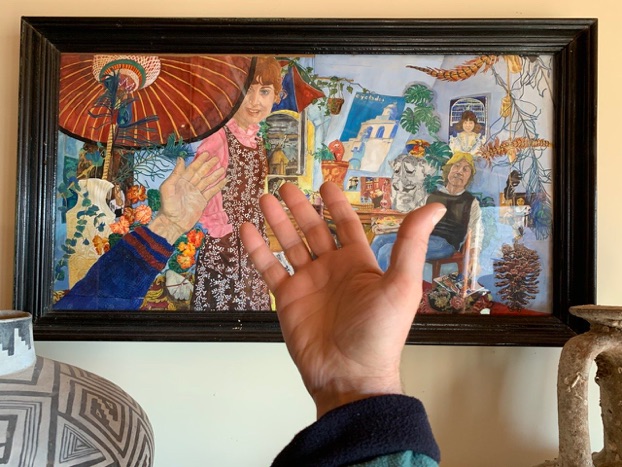
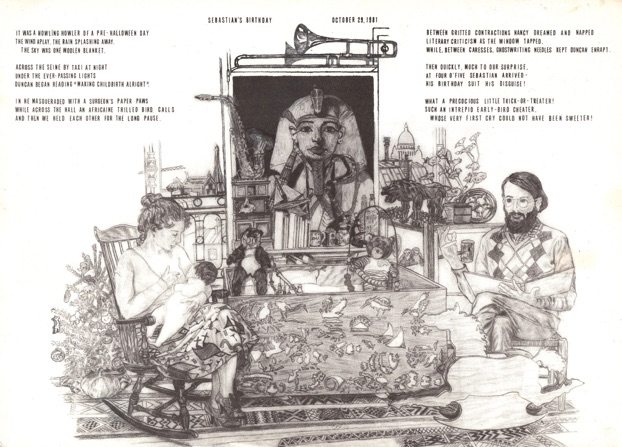
This was our son, Sebastian’s, birth announcement. Nancy composed the poem 6 hours after giving birth with an African mother trilling birdsongs as she pushed across the hall. The Christmas tree behind the rocking chair represents the day when Sebastian was expected while the pumpkin below stands for the time of year when he really arrived - two months early on October 29, 1981. The holes I jigsawed in his rocking cradle formed a seascape of crabs and sculpins with porcupine and clown fish above them, then a tern slamming a fish, stalking herons, a floating swan, and even a Portuguese man-of-war grappling a minnow at top. My sawing came to an abrupt halt with Sebastian’s unexpectedly early arrival and we began using the cradle before it was finished. Our lovebirds, Mango and Penguin, can be seen cuddling under the wooden lion and view of Sacre Coeur.
Sebastian’s Birthday
October 29, 1981
It was a howling howler of a pre-Halloween day
The wind a-play, the rain splashing away.
The sky one woolen blanket.
Across the Seine by taxi at night
Under the ever-passing lights
Duncan began reading “Making Childbirth Alright.”
In he masqueraded with a surgeon’s paper paws
While across the hall, an Africaine trilled bird calls
And then we held each other for the long pause.
Between gritted contractions, Nancy dreamed and napped
Literary criticism as the window tapped,
While, between caresses, ghostwriting needles kept Duncan enrapt.
Then quickly, much to our surprise,
At four o’five, Sebastian arrived –
His birthday suit his disguise!
What a precocious little trick-or-treater!
Such an intrepid early-bird cheater,
Whose very first cry could not have been sweeter!
One of our closest friends, Ted Joans - or, as he was known to our children, Uncle Rotapep (short for rhino-okapi-tapir-aardvark-pangolin-echidna-platypus - his adopted totem animals) - once told me he’d devoted a lecture at Harvard - where he was poet-in-residence - to describing my paintings as the work of the “Father of Clutterism”. Talk about a warm but back-handed compliment! Another artist, Eleanor Hubbard, probably nailed my style by calling it the product of a diarist painter who portrays travelers through the spaces they’ve filled.
© 1976 onwards Duncan Caldwell

